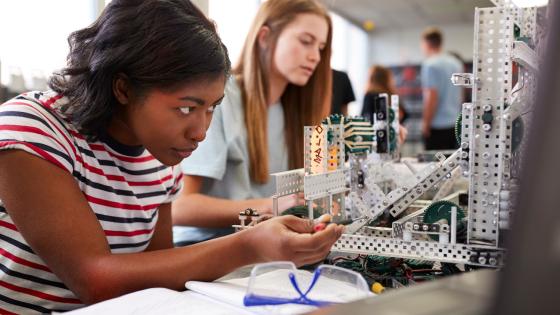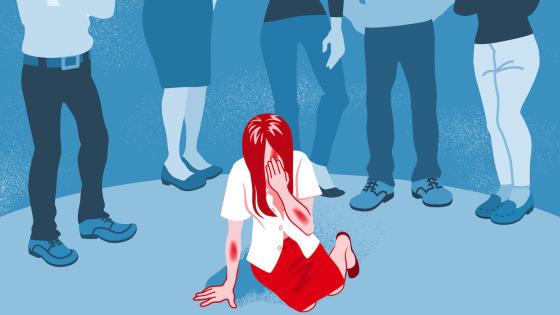The birth rate among teenage girls in the US has fallen dramatically from 61.8 per thousand 15-19 year old girls in 1991, to 29.4 in 2012 (Hamilton, Martin and Ventura 2013). Nevertheless, high teen birth rates continue to be a major public-policy issue in the US, and in many other developed countries. At first glance, it is obvious that teen motherhood is a problem for the teens, their children, and society.
- Women who gave birth as teens have much worse outcomes as adults than those who did not. And children born to teen mothers have worse outcomes than those born to older mothers.
Both the mothers and their children are more likely to receive social welfare payments. Therefore, it seems self-evident that programs that teach teens the cost of early child-bearing will reduce teen pregnancy, and ultimately give those teens and their future offspring better lives.
This view prevails despite over two decades of research (e.g. Geronimus and Korenman1992) that calls it into question.
- Women who gave birth as teens tend to have had disadvantaged childhoods.
Is it their backgrounds that lead to poor outcomes, or could we eliminate their disadvantage solely by convincing them not to become teen mothers? Or does the truth lie somewhere in between?
Is teenage motherhood really the problem?
If teen motherhood really is costly, then many teenage girls are either uninformed about its costs, or too impulsive to act on this information. Providing them with better information and the ability to avoid impulsive behaviour would be effective policy. But, if the real reason teen mothers have bad outcomes is that they were already disadvantaged, they are likely to ignore the incorrect information, especially since it violates their own experience. And, if teen motherhood is not the problem, changing the teens’ behaviour so that they avoid motherhood, will not help them.
Distinguishing correlation from causality is difficult. We do not get to conduct experiments in which we randomly force some teens to give birth and others not to. And, even if some mad social scientist were to conduct such an experiment, he would get the wrong answer. We are not interested in the hypothetical effect of giving birth on a random teen, but the effect on teens that are sexually active, do not use effective birth control, and would not have an abortion if they became pregnant. The cost of a birth might be very high for teens at no risk of giving birth, but unless we are considering teen pregnancy promotion programs, that is irrelevant. Ideally, we would like to know how delaying birth would affect the outcomes of teens (and their children) whose behaviour would be affected by a teen pregnancy prevention programme.
We cannot identify this target group perfectly, but we can get close. Joseph Hotz, Susan McElroy and Seth Sanders (2005) pointed out that teens who miscarry provide a good comparison group for those who give birth. Both groups were sexually active and did not use effective contraception. Moreover, miscarriage is pretty much medically random. Hotz, McElroy and Sanders treat women who miscarried as teens as a random sample of those who would have otherwise given birth, or chosen to have an abortion. They find that most of the adverse effects of teen motherhood are short-lived. By age 28, teen mothers worked more and earned more than their counterparts who had miscarried. By this age, the difference in the number of children was small, suggesting that teen motherhood largely affects the timing of births. Arline Geronimus (1987) suggests that, at least among disadvantaged African-Americans, health outcomes may be better for the children of teen mothers than they would be if the mothers delayed motherhood until their mid-20s.
But the Hotz, McElroy and Sanders results are a little too positive. The problem is that women who would choose to have an abortion are at risk of a miscarriage over a shorter period than those who would not, and are therefore under-represented among the sample of miscarriages. Since among teens who get pregnant, those who have abortions are drawn from more advantaged backgrounds, this leads to a benign view of teen motherhood. However, we can also compare teens who miscarried with teens who gave birth. This is also biased, but towards an adverse view of teen births, because miscarriages include some teens who would have had abortions while births, by definition, do not. Adam Ashcraft and I (2006) show that these two approaches place fairly tight bounds on the effects of teen motherhood, and that the effects, while adverse, are probably small.
In more recent work, Ashcraft, Ivan Fernandez-Val and I (2013) show that it is possible to address the technical complexities caused by abortion in two different ways. We can take a weighted average of the two biased estimates, or we can compare the outcomes for teens who gave birth with the outcomes for the miscarriage group adjusted for the presence of women who would have had abortions had they not miscarried. The results are consistent across a variety of approaches and specifications.
- There is no evidence of large adverse effects of teen motherhood on adult outcomes. The most consistent results are that the teen mothers are a few percentage points less likely to be married and more likely to be divorced, and a few percentage points less likely to have either a high school diploma, or to have passed a high school equivalency exam.
None of these studies quite answers the question we set out earlier, the effect of teen motherhood on the types of teens whose pregnancy might be prevented by a teen pregnancy prevention program. Miscarriages happen randomly. Therefore, studies that rely on miscarriage to make (non)-births random do not necessarily tell us about the effects on teens whose behaviour might be altered by a program. And, in fact, one reason that the difference in outcomes between teens who miscarry and those who give birth may be small, is that many teens who miscarry get pregnant again and give birth as a teen anyway. We estimate that 31% of teens who miscarry and who would not have had an abortion subsequently give birth as a teen. If we treat the set of teens who would not have had an abortion but who miscarry and who do not subsequently give birth as a teen as representative of teens whose behaviour might be changed by an education program, our estimates still suggest that avoiding a teen birth would have little effect on their adult outcomes.
The real key is changing the environment
The real key to addressing teen motherhood is changing the environment. Russell Weinstein and I (2012) find that in the 1950s, and much of the 1960s, when the teen birth rate was two and a half times its current rate in the US, many women benefited from teen pregnancy. Even among those who were not married at the time of conception, relatively disadvantaged girls who gave birth had higher family incomes than those who miscarried as teens. Times have changed. Teen birth rates have fallen because, for most girls, giving birth as a teen is a bad choice, and therefore they avoid it.
But there remains a segment for whom the choice appears to be low cost, and possibly even beneficial. Girls who expect their health to deteriorate in their twenties and/or who do not expect to have adequate financial resources may well conclude that they should have their children while still healthy and while their mothers are still young enough to help with the grandchildren. Since this conclusion may be correct, ‘better education’ will not solve the problem. Instead, our focus must be on providing the types of opportunities that disadvantaged women will not want to forgo due to a teen birth.
References
Ashcraft, Adam and Kevin Lang, (2006), “The Consequences of Teenage Childbearing”, National Bureau of Economic Research Working Paper No. 12485.
Ashcraft, Adam, Ivan Fernández-Val, Kevin Lang (2013), “The Consequences of Teenage Childbearing: Consistent Estimates When Abortion Makes Miscarriage Non-random,” Economic Journal, 123 (571) (September): 875-905;
Geronimus, Arline T. (1987) “On Teenage Childbearing and Neonatal Mortality in the US,” Population and Development Review, 13: 2 (June): 245-279.
Geronimus, Arline T. and Sanders Korenman (1992), “The Socioeconomic Consequences of Teen Childbearing Reconsidered,” Quarterly Journal of Economics 107 (4): 1187-1214 doi:10.2307/2118385.
Hotz, V. Joseph, Susuan Williams McElroy and Seth G. Sanders (2005), “Teenage Childbearing and Its Life Cycle Consequences,” Journal of Human Resources, 40 (3): 683-715.
Hamilton, B. E., Martin, J.A. & Ventura, S. J.(2013). Births: Preliminary data for 2012. Hyattsville, MD: National Center for Health Statistics. Retrieved September 30, 2013, from http://www.cdc.gov/nchs/data/nvsr/nvsr62/nvsr62_03.pdf.
Lang, Kevin and Russell Weinstein (2012), “Evaluating Student Outcomes at For-Profit Colleges,” NBER Working Paper No. 18201.


